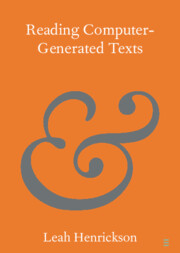Element contents
Reading Computer-Generated Texts
Published online by Cambridge University Press: 18 January 2021
Summary
Keywords
- Type
- Element
- Information
- Online ISBN: 9781108906463Publisher: Cambridge University PressPrint publication: 11 February 2021
References
- 9
- Cited by



